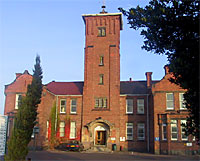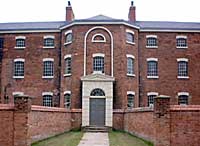
Structual
Basford
The original building, designed for 240 inmates, was erected in 1815 and taken over by the Basford Poor Law Union in 1836. A new infirmary was added in 1901 to which was added a group of children’s cottage homes c.1910. The site became Basford County Institution after 1930 and Highbury Hospital in 1948. Part of the original workhouse survives although the site is currently (2008) being redeveloped and many of the 20th century structures have been demolished.
Bingham
A new workhouse was constructed by the Bingham Poor Law Union on a two-acre site in 1836. The building became the Bingham Public Assistance Institution after 1930 and was used as a home for the elderly and infirm until 1965. It was demolished in 1967.
East Retford
The workhouse for 200 inmates was erected by the newly formed East Retford Poor Law Union in 1836-38 on Spital Hill in Retford. It became part of the NHS in 1948 and was known as Hillcrest Hospital until demolition in the early 1970s.
Mansfield
The workhouse was constructed on Stockwell Gate in 1837 and was designed to accommodate 300 inmates. It became the Mansfield County Institution after 1930 while the infirmary later became part of the Victoria Hospital. Mansfield Community Hospital now covers the site and virtually all traces of the workhouse buildings have gone. The infirmary block survived until 2007 when it was demolished when the site was redeveloped.
Newark
A workhouse was built at Claypole Bridge in Lincolnshire in 1817. In 1836 an earlier workhouse on Hawton Road in Newark and the Claypole workhouse were adopted by the Newark Poor Law Union. An infirmary was built on a site on Bowbridge Lane, Newark, in 1878 and an administrative block and second ward block were added in 1904. The Claypole buildings were sold off in 1913 and demolished in 1978 but part of the Hawton Road workhouse survives. Newark Hospital now occupies the infirmary site.
Nottingham

Administration block for Bagthorpe Workhouse.
A workhouse on York Street was built in 1840 but was demolished in 1896 to make way for Victoria Station. The Nottingham Poor Law Union erected a replacement at Bagthorpe in 1898-1903, designed by the Nottingham Architect, Arthur Marshall. The new workhouse was designed to hold 1,791 inmates. The accommodation blocks were located on the south of the site with a central administrative block and kitchen and dining rooms behind it. The infirmary stood on the north side of the site.
The workhouse was renamed Valebrook Lodge in 1937, then became City Hospital South and subsequently was known as Sherwood Hospital from 1951. The infirmary (once known as Bagthorpe Infirmary) became City Infirmary from the 1930s then was renamed City Hospital. The workhouse administration block, chapel and a number of minor buildings survive on the Nottingham City Hospital site.
Radford
Radford Poor Law Union built a new workhouse for 200 inmates in 1837-38 on Hartley Road. The Union was dissolved in 1880 and became part of the Nottingham Union . The workhouse building was demolished in the 1960s.
Southwell

Southwell Workhouse © Copyright David Barnes and licensed for reuse under this Creative Commons Licence
A workhouse for 84 inmates was built on Nottingham Road in 1808. The building proved to be too small so it was sold and was converted to a Baptist Chapel in 1839.
The Thurgarton Incorporation workhouse in Upton parish opened in 1824 and was designed to hold 158 inmates. It later became Greet House, a home of the elderly and a social services hotel. The National Trust acquired the site in the 1980s and has restored the workhouse to its original state.
Trent & Peak Archaeology have commissioned a laser scan flythrough video showing the building from a wide variety of angles:
Worksop
The Worksop Poor Law Union constructed a workhouse for 400 inmates on East Gate in the 1830s. The buildings were demolished in the 1960s. An associated infirmary was built at Kilton Hill in 1901-04 which became Kilton Hill Hospital from 1948 until the 1980s when Bassetlaw District Hospital was built on the site.
Information, maps and photographs of all these workhouses are available on Peter Higginbotham's excellent The Workhouse website: